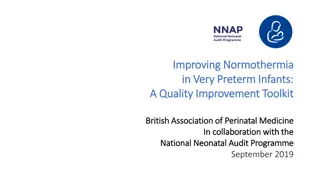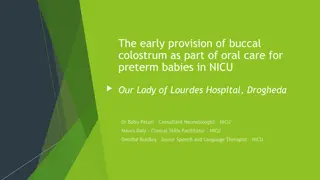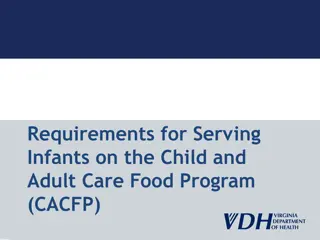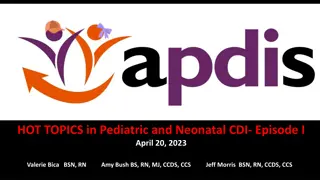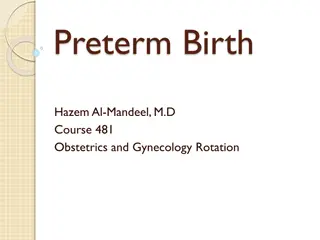Understanding Preterm Labor and Its Impact on Infant Health
Preterm labor, defined as the delivery of an infant before 37 weeks of gestation, presents risks such as incomplete organ system development and increased infant mortality rates. Unnecessary obstetrical interventions before 38-39 weeks should be avoided. The trends in preterm birth rates reveal disparities among different racial and ethnic groups. Recognizing the importance of managing preterm labor is crucial for improving maternal and infant health outcomes.
Download Presentation

Please find below an Image/Link to download the presentation.
The content on the website is provided AS IS for your information and personal use only. It may not be sold, licensed, or shared on other websites without obtaining consent from the author. Download presentation by click this link. If you encounter any issues during the download, it is possible that the publisher has removed the file from their server.
E N D
Presentation Transcript
PRETERM LABOR . . . . .
PRETERM LABOR Overview Definition Diagnosis Management Screening &Prevention
Incomplete development of various organ system PREMATURITY REPRESENTS Especially lungs Respiratory distress syndrome
DEFINITION Preterm infant : delivered before 37 completed weeks 36 6/7 weeks WHO and FIGO
DEFINITION Early preterm : before 33 6/7 weeks Late preterm : between 34 and 36 completed weeks
INFANT MORTALITY RATES IN THE UNITED STATES IN 2009 Live Birth No. (%) 4,130,665 (100 ) Infant Deaths ( per 1000 births ) 26,408 ( 6 ) Total infant birth Gestational age at birth 144,961 (4) 357,345 (9) 502,306 (12) 1,138,029 (28 ) 2,256,457 (55) 228,588 (6) 15,000 (104) 2,549 (7 ) 17,550 (35) 3521 (3 ) 4474 (2) 654(3) < 34 weeks 34-36 weeks <37 weeks 37-38 weeks 39-40 weeks 42 weeks Adapted from Mathews,2013
Unnecessary obstetrical intervention are not occurring before 38 or 39 weeks
TRENDS IN PRETERM BIRTH RATES - The preterm birth rate in the United States 2003 : 12.3% - In Canada : 7.7% - 77% of the race/ethnicity-related disparity in infant mortality rate in the United States in 2009 was associated with preterm birth ( Mathews, 2013 )
PRETERM BIRTHS IN THE UNITED STATES IN 2011 ACCORDING TO MATERNAL RACE AND ETHINICITY 16.8 18 16 14 10.5 11.7 12 10.4 10 8 6 13.5 4 2 0 non-hispanic white non-hispanic black hispanic American Indian or Alaska Native Asian or Pacific Islander
PRETERM IN PGH ( <10% ) . . . .2561- . .2562 Chart Title 12.65 11.49 11.18 9.7 9.21 8.88 OCT-61 NOV-61 DEC-61 JAN-62 FEB-62 MAR-62 Column3 Column1 Column2
MORBIDITY IN PRETERM INFANTS Organ system immaturity
MAJOR SHORT AND LONG-TERM PROBLEMS IN VERY-LOW-BIRTHWEIGHT INFANTS Organ or System Short-Term problems Long-Term Problems Pulmonary RDS, air leak, bronchopulmonary dysplasia, apnea of prematurity bronchopulmonary dysplasia, reactive airway disease, asthma hyperbilirubinemia, feeding intolerance, necrotizing enterocolitis, growth failure Failure to thrive, short-bowel syndrome, cholestasis GI Hospital-acquired infection, immune deficiency, perinatal infection Respiratory syncytial virus infection, bronchiolitis Immunological
Organ or System Short-Term problems Long-Term Problems Central nervous system Intraventricular hemorrhage, periventricular leukomalacia, hydrocephalus Cerebral palsy, hydrocephalus, cerebral atrophy, neurodevelopmental delay, hearling loss Opthalmological Retinopathy of prematurity Blindness, retinal detachment, myopia, strabismus Cardiovascular Hypotension, patent ductus arteriosus, pulmonary hypertension Pulmonary hypertension, hypertension in adulthood Renal water and electrolyte imbalance, acid-base disturbances Hypertension in adulthood
Organ or System Short-Term problems Long-Term Problems Hematological Iatrogenic anemia, need for frequent transfusions, anemia of prematurity Endocrinological Hypoglycemia, transiently low thyroxine levels, cortisol deficiency Impaired glucose regulation, increased insulin resistance Data from Eichenwald,2008
MORTALITY AND MORBIDITY AT THE EXTREMES OF PREMATURITY Infants delivered at 33 weeks : tremendous advances in the perinatal and neonatal care Survival of increasingly very immature infants in the 1990s Uncertainly and controversy as the lower limit of fetal maturation compatible with extrauterine survival
THRESHOLD OF VIABILITY Birth before 26 weeks : current threshold of viability Fragile and vulnerable because immature organ system Brain injury from hypoxic-ischemic injury and sepsis
THRESHOLD OF VIABILITY IN THAILAND Threshold of viability 24 500
SURVIVAL AND DISABILITY RATES FOR 5736 LIVE BIRTHS BORN BETWEEN 22 AND 26 WEEKS GESTATION AT 20 MEDICAL CENTERS IN THE UNITED STATES DURING 2003-2007 Gestational age (wk) 22 23 24 25 26 Outcome 471 6 26 55 72 84 871 1370 1498 1576 Liveborn infant (NO. ) Survived to discharge (%) 0 8 9 20 34 Percentage with no chronic morbidity Morbidities included severe IVH, perventricular leukomalacia, bronchopulmonary dysplasia, necrotizing enterocolitis, infection and retinopathy of prematurty Adapted from Stoll, 2010
THRESHOLD OF VIABILITY AT PARKLAND HOSPITAL -All fetal indications for cesarean delivery are practiced in women at 25 weeks - At 24 weeks, cesarean delivery is not offered unless fetal weight is estimated at 750 g or greater
LATE PRETERM BIRTH - Infants between 34 and 36 weeks - More than 70% of all preterm births - Respiratory morbidity decreased by approximately 50% per week from 34 to 37 weeks
Distribution in percent of preterm births in the United States for 2004 ( Redraen from Martin, 2006) Sales < 28 6% 34-36 28-31 10% 32-33 13% 32-33 34-36 71% 28-31 < 28
CAUSES OF PRETERM DELIVERY 4 main reasons for preterm births in United States Spontaneous unexplained preterm labor with intact membranes Idiopathic preterm premature rupture of membranes (PPROM) Delivery for maternal or fetal indications Twins and higher-order multifetal births
PPROM and spontaneous preterm labor : 70-80% of preterm births Interacting, antecedents, contributing factors REASONS FOR PRETERM BIRTH
UTERINE DISTENTION MATERNAL-FETAL STRESS INFECTION PREMATURE CERVICAL CHANGE BASIC SCIENCE OF SPONTANEOUS PRETERM LABOR
Bacterial can access to intrauterine tissues through Sources for intrauterine infection 1. Transplacental transfer of maternal systemic infection 2. Retrograde flow of infection into the peritoneal cavity via INFECTION 3. Ascending infection with bacteria from the vagina and cervix Fallopian tubes
Categorize intrauterine infection into 4 stages of microbial invasion that Stage 1 : bacterial vaginosis Stage 2 : decidual infection Stage 3 : amnionic infection Stage 4 : fetal systemic infection INFECTION
PRETERM PREMATURE RUPTURE OF MEMBRANES Major predisposing event : intrauterine infection Associated risk factors Low socioeconomic status Body mass index 19.8 Nutritional deficiencies Cigarette smoking *****Despite these known risk factors, none is identified in most cases of preterm labor
- Preterm parturition syndrome ( Romero 2006 ) : multiple etiologies - Intrauterine infection : some cases categorized as idiopathic spontaneous preterm labor - Infection : not explain all causes of preterm birth - Maternal nutrition, genetics, the vaginal microbiome and dynamic regulation of the extracellular matrix SUMMARY OF PRETERM LABOR PATHOPHYSIOLOGY
ANTECEDENTS AND CONTRIBUTING FACTORS Threatened abortion : Subsequent preterm labor, placental abruption and subsequent pregnancy loss before 24 weeks ( Weiss 2004 )
ANTECEDENTS AND CONTRIBUTING FACTORS Lifestyle factors Cigarette smoking Inadequate maternal weight gain Illicit drug use Overweight and obese mothers ( Cnattingius, 2013 ) Advance maternal age
ANTECEDENTS AND CONTRIBUTING FACTORS Lifestyle factors Depression, anxiety, and chronic stress ( Copper, 1996; Li, 2008;Littleton, 2007 ) Working long hours and hard physical labor ( Luke, 1995 )
ANTECEDENTS AND CONTRIBUTING FACTORS Genetic factors - May play a cause role - Recurrent, familial, and racial nature of preterm birth - Immunoregulatory genes in potentiating chorioamnionitis in case of preterm delivery ( Varner,2005 )
ANTECEDENTS AND CONTRIBUTING FACTORS Birth defects Birth defects was associated with preterm birth and low birthweight (Dolan, 2007)
ANTECEDENTS AND CONTRIBUTING FACTORS Periodontal disease - Significantly associated with preterm labor ( Vergnes and Sixou, 2007 ) - The data were not robust enough to recommend screening and treatment of pregnant women (Stamilio, 2007) - Treatment periodontal disease during pregnant : failed to significantly alter preterm birth rate (Michalowictz, 2006)
ANTECEDENTS AND CONTRIBUTING FACTORS Interval between pregnancies Interval < 18 months and > 59 months : associated with increased risks for both preterm birth and SGA newborns
ANTECEDENTS AND CONTRIBUTING FACTORS Prior preterm labor - Major risk factors for preterm labor ******
RECURRENT SPONTANEOUS PRETERM BIRTHS ACCORDING TO PRIOR OUTCOME Birth Outcome Second Birth 34 weeks (%) First birth 35 weeks 5 First birth 34 weeks 16 41 First and second birth 34 weeks Data from 15,863 women delivering their first and subsequent pregnancies at Parkland Hospital. Adapt fro Bloom, 2001
ANTECEDENTS AND CONTRIBUTING FACTORS Bacterial vaginosis BV : associated with spontaneous abortion, preterm labor, PPROM, chorioamnionitis and amnionic fluid infection :Associated with BV : chronic stress, ethnic differences and frequent or recent douching
24 ( uncertain date 500 g. ) 36 6/7 1. 4 20 8 60 PRETERM LABOR : DIAGNOSIS 2. 1 cm 3. 80
Admit in LR Notified Delivery NPO IV Fluid On external fetal monitoring uterine contraction Vital sign + ATB prophylaxis Group B Streptococci active phase tocolytic drugs steroid PRETERM LABOR : GA 34 WEEKS
- PRETERM LABOR: GA 34 WEEKS - 2000 : cs or vaginal delivery 2000 : cs
o 18 G1P0 GA 32 weeks by date .. PRETERM LABOR : GA < 34 1 . . . oANC at PGH WEEKS oFirst US at GA 20 weeks , GA = date oNo underlying disease
PV : swab gram stain and culture AT LR cervix was opened 2cm , dilate 100% , station 0 , membrane intact Diagnosis : GA 32 weeks with preterm labor
GA 32 WEEKS WITH PRETERM LABOR admit at LR Notified Expectant management
GA 32 WEEKS WITH PRETERM LABOR Maternal Underlying disease : HT,GDM, heart disease, hyperthyroid VITAL SIGN : Temp, BP, pulse Cause of preterm labor ; Cervical swab gram stain and culture , UA Biochemistry : CBC, BUN, Cr, electrolyte, BS
GA 32 WEEKS WITH PRETERM LABOR Fetus Confirm GA, , fetal weight On external fetal monitoring
GA < 34 WEEKS WITH PRETERM LABOR NPO ( tocolytic drugs ) Steroid : Dexamethasone 6mg im q 12 hours x 4 doses ATB : prevent Group B Steptococci ( GBS ) when active phase
For GA start at viable-336/7 weeks First line TOCOLYTIC 1. calcium channel blockers- nifedipine ( Adalat ) DRUGS 2. beta-adrenergic receptor agonist ( terbutaline/ Bricanyl ) 3. prostaglandin inhibitors : NSAIDs



